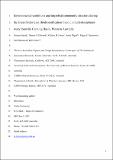Environmental conditions and microbial community structure during the Great Ordovician Biodiversification Event; a multi-disciplinary study from the Canning Basin, Western Australia
Author(s)
Spaak, Gemma; Edwards, Dianne S.; Foster, Clinton B.; Pagès, Anais; Summons, Roger E; Sherwood, Neil; Grice, Kliti; ... Show more Show less
DownloadAccepted version (6.917Mb)
Terms of use
Metadata
Show full item recordAbstract
The Great Ordovician Biodiversification Event (GOBE) is regarded as one of the most significant evolutionary events in the history of Phanerozoic life. The present study integrates palynological, petrographic, molecular and stable isotopic (δ 13 C of biomarkers) analyses of cores from four boreholes that intersected the Goldwyer Formation, Canning Basin, Western Australia, to determine depositional environments and microbial diversity within a Middle Ordovician epicontinental, tropical sea. Data from this study indicate lateral and temporal variations in lipid biomarker assemblages extracted from Goldwyer Formation rock samples. These variations likely reflect changing redox conditions between the upper (Unit 4) and lower (Units 1 + 2) Goldwyer, which is largely consistent with existing depositional models for the Goldwyer Formation. Cryptospores were identified in Unit 4 in the Theia-1 well and are most likely derived from bryophyte-like plants, making this is the oldest record of land plants in Australian Middle Ordovician strata. Biomarkers in several samples from Unit 4 that also support derivation from terrestrial organic matter include benzonaphthofurans and δ 13 C-depleted mid-chain n-alkanes. Typical Ordovician marine organisms including acritarchs, chitinozoans, conodonts and graptolites were present in the lower and upper Goldwyer Formation, whereas the enigmatic organism Gloeocapsomorpha prisca (G. prisca) was only detected in Unit 4. The correlation of a strong G. prisca biosignature with high 3-methylhopane indices and 13 C depleted G. prisca–derived chemical fossils (biomarkers) is interpreted to suggest an ecological relationship between methanotrophs and G. prisca. This research contributes to a greater understanding of Ordovician marine environments from a molecular perspective since few biomarker studies have been undertaken on age-equivalent sections. Furthermore, the identification of the oldest cryptospores in Australia and their corresponding terrestrial biomarkers provides further insight into the geographical distribution and evolution of early land plants.
Date issued
2017-12Department
Massachusetts Institute of Technology. Department of Earth, Atmospheric, and Planetary SciencesJournal
Global and Planetary Change
Publisher
Elsevier BV
Citation
Spaak, Gemma et al. "Environmental conditions and microbial community structure during the Great Ordovician Biodiversification Event; a multi-disciplinary study from the Canning Basin, Western Australia." Global and Planetary Change 159 (December 2017): 93-112 © 2017 Elsevier B.V.
Version: Author's final manuscript
ISSN
0921-8181